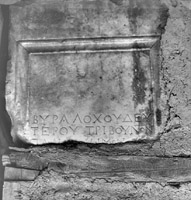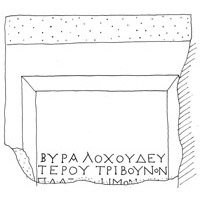 MAMA XI 105 (Akmoneia)
MAMA XI 105 (Akmoneia) 
Honorific base for a Roman senator
- Type of monument:
- Honorific base.
- Location:
- Ahat (Akmoneia): in the wall of a house.
- Description:
- White marble base with traces of upper moulding, with moulded panels on front and left (back and right hidden), broken below.
- Dimensions:
- Ht. 0.54+; W. 0.58 (panel 0.42); Th. 0.58; letters mostly 0.012-0.031.
- Record:
- Line drawing; MB notebook copy; photograph (1955/104).
- Publication:
- None.
- Date:
- Roman imperial period.
Right face (?)
[- - - - - - - - - - - -]
[- - - - - - - - - - σή]
Surviving face
βυρα λόχου δευ-
τέρου τριβοῦνον
πλ̣α̣τ̣[ύ]σ̣η̣μον [λεγ]-
[ιῶνος - - - - - - - -]
...[Se]vir (equitum Romanorum) turmae II, tribunus laticlavius [legionis]...





This monument is an honorific base for an unidentifiable Roman senator. The surviving text consists of three lines from the middle of the description of the senator’s cursus. There is nothing inscribed on the panel above line 1, and no sign of an erasure; the text must have begun on the invisible right face of the monument. For another monument laid out in the same manner (beginning on one face, then continuing on the face to the left), see MAMA XI 164 (1956/10: Kidyessos).
The first four letters of the surviving text, βυρα, can only represent the end of the accusative [σή]βυρα, a transliteration of the Latin term sevir. The term seems otherwise only to be attested in Greek in the fragmentary career inscription IGUR I 72, in which the anonymous senator is described as [χιλίαρχο]ν πλατύσημο[ν λεγιῶνος . . ?Γεμί]νης, σήουιρα [ - - - ]. I know no exact parallel for Gk *βῦρ = Lat. vir, but compare I.Ephesos 3035 (C. Iulius Thrason Alexandros: PIR2 I 600), in which the office of triumvir capitalis is transliterated as τριούμβουρα καπιτᾶλιν. The spelling vyr for vir is castigated in the Latin grammatical tradition (Baehrens 1922: 52-3).
In all three of these texts, the Latin noun vir is treated as though it were a Greek third-declension noun (nom. -βυρ/-βουρ/-ουιρ, acc. -βυρα/-βουρα/-ουιρα). Similarly, in several inscriptions from Pergamon, C. Antius A. Julius Quadratus (PIR2 I 507; Halfmann 1979: 112-5) is described as σεπτέμουιρα ἐπουλώνουμ, i.e. VIIvir epulonum (IGR IV 275, 374, 383). Elsewhere, the transliterated noun vir is occasionally treated as if it were a Greek second-declension noun: so in TAM II 278 (Xanthos), the consul Pollienus Auspex (PIR2 P 537; Birley 2005: 348-51) is described as κυινδεκεμουίρου (gen.), and in IG XII 2, 235 (Mytilene), M. Pompeius Macrinus (PIR2 P 628) is described as κ̣ουαττόρουιρον (acc.). Most frequently, however, the Latin second-declension accusative -um is simply transliterated: cf. IGR IV 384, σεμπτεμουίρουμ (Pergamon); SEG 17, 569 (+SEG 42, 1227), σεπτεμουίρουμ ἐπουλώνουμ (Attaleia, M. Petronius Umbrinus: PIR2 P 320); SEG 17, 571, κουαττορουίρουμ οὐιάρουμ κουρανδάρουμ (Attaleia, L. Marcius Celer Calpurnius Longus: PIR2 M 221).
For the seviri equitum Romanorum and the six turmae equorum publicorum, see Mommsen, Staatsrecht III 523-5; Taylor 1924; Demougin 1988: 217-43. The Greek term λόχος normally translates the Latin centuria; our text appears to be the first unambiguous instance of Gk λόχος = Lat. turma. However, the absence of any apparent reference to the turmae in Dionysios of Halikarnassos’ description of the transvectio equitum at 6.13.4 is surprising to say the least (Mommsen, Staatsrecht III 522 n.1; Le Bohec 1975: 118-9; Demougin 1988: 252-3), and it is possible that his phrase κατὰ φυλάς τε καὶ λόχους should be translated ‘by tribes and by turmae’.